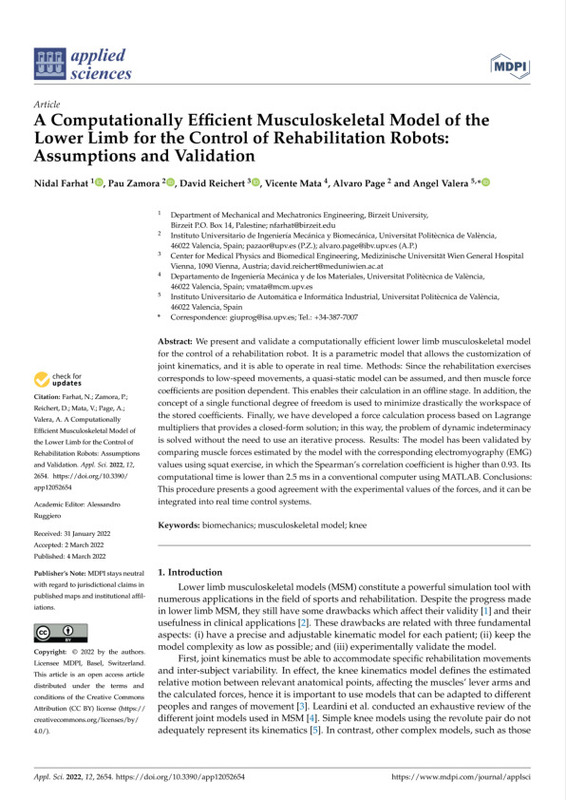JavaScript is disabled for your browser. Some features of this site may not work without it.
Buscar en RiuNet
Listar
Mi cuenta
Estadísticas
Ayuda RiuNet
Admin. UPV
A Computationally Efficient Musculoskeletal Model of the Lower Limb for the Control of Rehabilitation Robots: Assumptions and Validation
Mostrar el registro sencillo del ítem
Ficheros en el ítem
| dc.contributor.author | Farhat, Nidal
|
es_ES |
| dc.contributor.author | Zamora-Ortiz, Pau
|
es_ES |
| dc.contributor.author | Reichert, David
|
es_ES |
| dc.contributor.author | Mata Amela, Vicente
|
es_ES |
| dc.contributor.author | Page Del Pozo, Alvaro Felipe
|
es_ES |
| dc.contributor.author | Valera Fernández, Ángel
|
es_ES |
| dc.date.accessioned | 2023-10-26T18:02:16Z | |
| dc.date.available | 2023-10-26T18:02:16Z | |
| dc.date.issued | 2022-03 | es_ES |
| dc.identifier.uri | http://hdl.handle.net/10251/198876 | |
| dc.description.abstract | [EN] We present and validate a computationally efficient lower limb musculoskeletal model for the control of a rehabilitation robot. It is a parametric model that allows the customization of joint kinematics, and it is able to operate in real time. Methods: Since the rehabilitation exercises corresponds to low-speed movements, a quasi-static model can be assumed, and then muscle force coefficients are position dependent. This enables their calculation in an offline stage. In addition, the concept of a single functional degree of freedom is used to minimize drastically the workspace of the stored coefficients. Finally, we have developed a force calculation process based on Lagrange multipliers that provides a closed-form solution; in this way, the problem of dynamic indeterminacy is solved without the need to use an iterative process. Results: The model has been validated by comparing muscle forces estimated by the model with the corresponding electromyography (EMG) values using squat exercise, in which the Spearman¿s correlation coefficient is higher than 0.93. Its computational time is lower than 2.5 ms in a conventional computer using MATLAB. Conclusions: This procedure presents a good agreement with the experimental values of the forces, and it can be integrated into real time control systems. | es_ES |
| dc.description.sponsorship | This research was partially funded by EU FEDER (predoctoral grant PRE2018-083847 and grand project "Sistema robotico paralelo con control basado en modelo musculo-esqueletico para la monitorizacion y entrenamiento del sistema propioceptivo", reference PID2021-125694OB-I00), and cofounded by Vicerrectorado de Investigacion de la Universitat Politecnica de Valencia (PAID-11-21). | es_ES |
| dc.language | Inglés | es_ES |
| dc.publisher | MDPI AG | es_ES |
| dc.relation.ispartof | Applied Sciences | es_ES |
| dc.rights | Reconocimiento (by) | es_ES |
| dc.subject | Biomechanics | es_ES |
| dc.subject | Musculoskeletal model | es_ES |
| dc.subject | Knee | es_ES |
| dc.subject.classification | INGENIERIA MECANICA | es_ES |
| dc.subject.classification | INGENIERIA DE SISTEMAS Y AUTOMATICA | es_ES |
| dc.subject.classification | FISICA APLICADA | es_ES |
| dc.title | A Computationally Efficient Musculoskeletal Model of the Lower Limb for the Control of Rehabilitation Robots: Assumptions and Validation | es_ES |
| dc.type | Artículo | es_ES |
| dc.identifier.doi | 10.3390/app12052654 | es_ES |
| dc.relation.projectID | info:eu-repo/grantAgreement/AEI//PRE2018-083847//AYUDA PARA CONTRATO PREDOCTORAL PARA LA FORMACION DE DOCTORES ZAMORA ORTIZ, PAU. PROYECTO: INTEGRACION DE MODELOS BIOMECANICOS EN EL DESARROLLO Y OPERACIONES DE ROBOTS REHABILITADORES RECONFIGURABLES/ | es_ES |
| dc.relation.projectID | info:eu-repo/grantAgreement/AEI//PID2021-125694OB-I00//SISTEMA ROBÓTICO PARALELO CON CONTROL BASADO EN MODELO MÚSCULO-ESQUELÉTICO PARA LA MONITORIZACIÓN Y ENTRENAMIENTO DEL SISTEMA PROPIOCEPTIVO/ | es_ES |
| dc.relation.projectID | info:eu-repo/grantAgreement/UPV-VIN//AYUDA PAID-11-21//Parallel rehabilitation robots: detection and control of singularities in the presence of manufacturing errors/ | es_ES |
| dc.rights.accessRights | Abierto | es_ES |
| dc.contributor.affiliation | Universitat Politècnica de València. Escola Tècnica Superior d'Enginyeria Informàtica | es_ES |
| dc.contributor.affiliation | Universitat Politècnica de València. Escuela Técnica Superior de Ingeniería del Diseño - Escola Tècnica Superior d'Enginyeria del Disseny | es_ES |
| dc.contributor.affiliation | Universitat Politècnica de València. Escuela Técnica Superior de Ingenieros de Telecomunicación - Escola Tècnica Superior d'Enginyers de Telecomunicació | es_ES |
| dc.contributor.affiliation | Universitat Politècnica de València. Departamento de Ingeniería Electrónica - Departament d'Enginyeria Electrònica | es_ES |
| dc.description.bibliographicCitation | Farhat, N.; Zamora-Ortiz, P.; Reichert, D.; Mata Amela, V.; Page Del Pozo, AF.; Valera Fernández, Á. (2022). A Computationally Efficient Musculoskeletal Model of the Lower Limb for the Control of Rehabilitation Robots: Assumptions and Validation. Applied Sciences. 12(5):2654-2670. https://doi.org/10.3390/app12052654 | es_ES |
| dc.description.accrualMethod | S | es_ES |
| dc.relation.publisherversion | https://doi.org/10.3390/app12052654 | es_ES |
| dc.description.upvformatpinicio | 2654 | es_ES |
| dc.description.upvformatpfin | 2670 | es_ES |
| dc.type.version | info:eu-repo/semantics/publishedVersion | es_ES |
| dc.description.volume | 12 | es_ES |
| dc.description.issue | 5 | es_ES |
| dc.identifier.eissn | 2076-3417 | es_ES |
| dc.relation.pasarela | S\459629 | es_ES |
| dc.contributor.funder | AGENCIA ESTATAL DE INVESTIGACION | es_ES |
| dc.contributor.funder | European Regional Development Fund | es_ES |
| dc.contributor.funder | UNIVERSIDAD POLITECNICA DE VALENCIA | es_ES |
| upv.costeAPC | 1866,55 | es_ES |








